Abstract
This study seeks to develop and evaluate a methodological framework for assessing the tourism potential of hillforts, by using a selected sample of 25 of these heritage resources located in the Lower Silesia Voivodeship. This region, as one of Poland’s most popular among domestic and international tourists, is increasingly confronting overtourism at its primary attractions. Concurrently, it possesses underutilised cultural assets, notably 250 remnants of gords/hillforts (grodziska in Polish) spanning various historical periods and dispersed across the whole area. Thus, to ensure the universality of the method, samples of hillforts from three main topographic zones of Lower Silesia were selected. In addition to the aim of testing the method, a secondary objective of the research involved conducting a preliminary assessment of selected hillforts’ tourism potential in different parts of the voivodeship. The methodology combined desk research and field studies across all selected archaeological sites. Concerning the primary objective, the developed assessment tool effectively replicated the multidimensional analytical framework characteristic of established methodologies, yielding reliable outcomes for evaluating gords’ tourism potential. However, modifications to the scoring system are recommended to enhance methodological precision. Regarding analysis of the 25 surveyed hillforts, the results indicate that objects from all zones mainly demonstrate high tourism potential, suggesting an opportunity for transformation into tourist attractions. The integration of hillforts into existing tourism infrastructure could significantly contribute to localised sustainable development across the region. The primary significance of these heritage resources lies in their capacity to facilitate the diversification of tourism offerings across distinct areas of the voivodeship. This development holds particular strategic value for northern poviats currently peripherally engaged in tourism economy. Moreover, by leveraging hillforts, communities obtain assets important in the process of building a common identity around cultural/historical place while safeguarding monuments. Concurrently, the most attractive southern poviats will benefit from the new attractions as they can help in mitigating overtourism pressures at overcrowded places, being an interesting alternative to the top attractions. This approach aligns with strategies to disperse tourist flows through specialised archaeological tourism products, thereby balancing economic benefits and local communities’ well-being with heritage preservation.
1. Introduction
The emergence and development of archaeology is one of the greatest triumphs in the history of science. Initially, this discipline was associated with treasure hunting, but over time it became an advanced, multidisciplinary science, combining history, anthropology, ethnography, geography, and many other fields [1]. Today, it is a vast and diverse science, studying everything: from primitive Palaeolithic stone tools from millions of years ago to contemporary landfill deposits, or garbage thrown out just yesterday. It covers the entire world, allowing us to discover the human past based on its material traces, especially where other sources are silent. Archaeology, as a powerful source of information, combined with elements of mystery and adventure, emphasised in numbers, popular-science books, and films [2], has become an important dimension in tourism exploration.
Archaeological heritage can be divided into two subgroups: immovable archaeological remains, which include archaeological sites, and movable archaeological relics, named artefacts [3]. Both of these groups are currently being intensively utilised in tourism, driven not only by growing public interest in material heritage but also by archaeologists’ increasing awareness of the need to engage in public archaeology [4]. Researchers are recognising the importance of democratising heritage for societal benefit—particularly for descendant communities—enhancing public engagement, and leveraging tourism as a means to secure funding for research, excavations, and conservation efforts [5,6]. With some delay, however, a similar process is developing dynamically in Poland, as exemplified by interdisciplinary research and conferences devoted to the popularisation of archaeology [7].
It is noteworthy that travel trends among Polish tourists align closely with those observed in other affluent European nations. Millennials are increasingly dominating the market as a key demographic, exhibiting a pronounced preference for off-the-beaten-track travel. This cohort predominantly favours emerging destinations perceived as offering “authentic” cultural experiences [8]. Such travel patterns may concurrently contribute to sustainable tourism practices, as these travellers consciously avoid overcrowded destinations impacted by overtourism, opting instead for underdeveloped regions [9]. Furthermore, industry reports from Poland in 2024 highlight a significant trend: the rising preference for lesser-known destinations by tourists, where they can see care for the environment and are offered local products. This is ranked as the second most prominent market shift [10]. This underscores a broader alignment between evolving consumer preferences and sustainability-driven tourism strategies.
Poland as a destination is experiencing a post-pandemic “boom.” Tourist traffic indicators have risen rapidly in recent years, with 2024 being a record year: 38.8 million tourists were accommodated in tourist accommodation establishments, marking a 7.2% increase compared to 2023 [11]. Similar national trends are observed in Lower Silesia, one of the most popular regions for both domestic and international tourists.
The region of Lower Silesia (Polish: Dolny Śląsk), located in the south-western part of Poland, is defined here within the administrative boundaries of the Lower Silesian Voivodeship (Figure 1). Both terms are used interchangeably throughout this article. While the physical–geographical and cultural boundaries of Lower Silesia are variably demarcated and often diverge from the voivodeship’s administrative area, the approach in this study is justified by two arguments. First, tourism development and management in Poland are primarily administered by local governance units (e.g., voivodeships), making this administrative framework relevant for applying the research outcomes in practice. Second, sustained regional identity-building initiatives within the voivodeship have increasingly conflated the term “Lower Silesia” with the administrative unit (voivodeship) in public discourse.
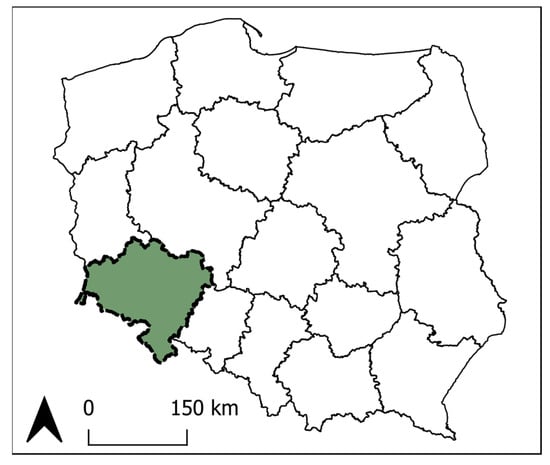
Figure 1.
Location of Lower Silesia Voivodship in Poland. Source: own elaboration.
In 2023, 4.2 million tourists stayed in Lower Silesian accommodations (a 12.3% rise from 2022), making it the third most visited destination in Poland [12]. A report on comparative studies of regions indicates that the Lower Silesian Voivodeship shows spatial differentiation in terms of tourist attractiveness [13]. At Statistics Poland’s request, poviat-level assessments of cultural, environmental, and business attractiveness indicators were conducted, subsequently synthesised into a composite tourist attractiveness index (Figure 2). In simplifying the results of the indicators for the purposes of this article, it can be stated that poviats obtaining index results between 0 and 3.78 are areas of low attractiveness. Poviats with a result between 3.79 and 8.51 have an attractiveness at a moderate level, the attractiveness of areas with a result from 8.52 to 13.69 can be defined as high, and that of areas with a result above 13.70 can be defined as very high. The spatial dispersion of results for the tourism attractiveness index shows a latitudinal pattern. It is evident that the northern zone of the voivodeship comprises poviats with low attractiveness in the western part (e.g., głogowski, górowski, lubiński) and moderate attractiveness in the eastern part (milicki, trzebnicki, oleśnicki). In the central belt of the voivodeship, poviats of moderate attractiveness definitely predominate, omitting three extreme areas: zgorzelecki with low attractiveness, and wrocławski and the city of Wrocław with high and very high attractiveness, respectively. Southern areas mainly exhibit high to very high attractiveness. Regardless of the methodological details of the study from the report, the presented results clearly correspond to the presentation of Wrocław and the southern areas of Lower Silesia, i.e., mountainous areas and foothills, as the most attractive in the region, established in travel guides [14,15]. These areas, therefore, experience both positive and negative effects of tourism development. Key attractions of Lower Silesia located within them increasingly face overtourism, exacerbated by the lengthening tourist season. Examples include the Karkonosze Mountains [16], the Stołowe Mountains [17], and Wrocław—the regional capital—which was visited by a record 6.2 million visitors in 2024 [18]. On the other hand, the northern and partly central areas, such as the city of Legnica, can benefit from tourism to a limited or minimal extent.
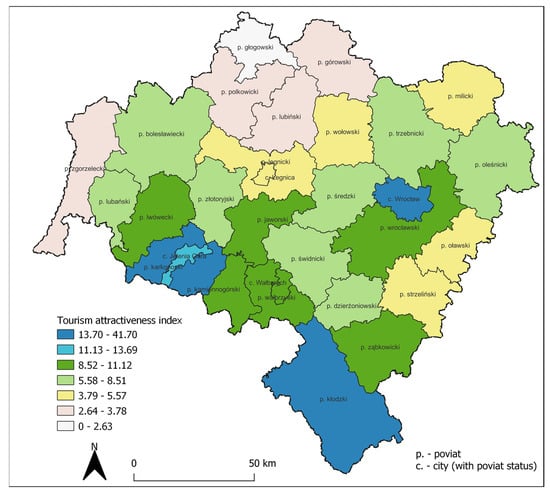
Figure 2.
Tourist attractiveness of poviats (based on the tourist attractiveness index). Source: own elaboration based on [13].
The tourism pressure in the southern poviats of the voivodeship underscores the urgency of dispersing tourist flows. In contrast, the limited development of tourism in northern and central-western areas demands a stimulus. Both issues could be addressed by similar solutions: new attractions or tourism products, especially those that correspond to the previously mentioned preferences of tourists, e.g., millennials. This point is critical to the sustainable tourism development of the region.
While Lower Silesia ranks among Poland’s most frequented tourist destinations, a significant proportion of its cultural heritage—particularly archaeological sites—remains underutilised. Official records from the Register of Archaeological Monuments (the national repository for protected sites of the top historical significance) document 1480 registered archaeological sites within the voivodeship, 268 of which are classified as defensive structures and hillforts [19]. These are distributed across all administrative units of the region, with at least one object present in every poviat. In terms of landscape, this region displays significant geomorphological diversity, encompassing mountainous terrain, foothills, lowlands, moraine ridges, and river valleys. This topographic variability has resulted in corresponding morphological diversity in the hillfort structures, making the Lower Silesia region ideally suited for testing the universality of the method’s criteria for assessing the tourism potential of different types of hillforts.
The primary objectives of this research are
- (1)
- To develop a standardised method for preliminarily assessing the tourism potential of gords;
- (2)
- To test its criteria’s universality to ensure their applicability for diverse forms of examined fortifications, located in areas with different terrain morphologies.
The methodological framework is structured around four core categories incorporated into the assessment, each systematically operationalised through detailed evaluation criteria (as outlined in the research methods section and further elaborated in the Appendix). The considered aspects in the method are
- Physical and morphological attributes;
- Accessibility and proximity to infrastructure;
- Conservation status;
- Representation in the tourism literature and digital media.
The selection of Lower Silesia as a geomorphologically heterogeneous study area serves dual purposes: it facilitates methodological validation while enabling the articulation of a secondary research objective. This objective specifically entails evaluating the tourism potential of selected hillforts within each designated topographical zone. In light of the previously documented intra-regional disparities in tourism attractiveness, the following hypotheses were formulated:
H1.
Due to the distribution of hillforts across zones with distinct terrain morphologies, hillforts exhibit significant variations in tourism potential scores.
H2.
Hillforts in the southern zone achieve the highest tourism potential ratings, reflecting the region’s established reputation as Lower Silesia’s most touristically attractive area.
2. Literature Review
2.1. Archaeological Tourism—Definition, Roles, and Impacts
Access to interpreted archaeological sites and collections has long been recognised as a catalyst for tourism development [20]. The utilisation of archaeological resources—both movable (e.g., artefacts) and immovable (e.g., structures)—enables visitors to engage with preserved heritage in its original context, acquire knowledge through museum collections, and interact with materials they may have only marginally learned about in school.
Archaeological tourism—sometimes referred to as archaeology-based tourism or archaeotourism [21]—is defined as an alternative form of cultural tourism that seeks to foster public interest in archaeological–historical monuments while advocating for their preservation [22]. Broadly conceptualised, it encompasses activities centred on ancient and historical sites, museums, and other archaeological resources [23,24]. Some definitions emphasise the centrality of archaeological objects, framing archaeotourism as “a form of heritage tourism that focuses on visits to archaeological sites, parks, and excavations, is sensitive to the delicate archaeological environment, and stimulates learning about past human activity” [21,25]. In the refreshed version of the operational guidelines presented by UNESCO, elements or structures of an archaeological nature are part of cultural heritage [26], hence at the same time being the subject of interest to heritage tourism.
Additionally, an attempt has recently been made to fill another significant gap in theoretical research on archaeotourism. One of the latest studies focused on a concept definition of archaeological tourism products and their systematisation in different types and components, which had not yet existed in the literature [27].
The utilisation of archaeological sites as tourist destinations remains a contentious topic, primarily due to their physical fragility and the divergent—often conflicting—visions for leveraging their vast interpretive potential. On the other hand, heritage tourism is also an incredible opportunity for archaeologists to reach out to the public, educate them, and nurture their interest not only in the history and prehistory of individual sites, but also in the methods, professional ethics, and current issues of archaeology [28].
Archaeological tourism, like cultural heritage tourism more broadly, is widely recognised as a developmental tool, delivering economic, social, and environmental benefits to destinations [29,30,31]. From an economic perspective, it drives revenue diversification, generates tax income, safeguards cultural resources as economic assets, and incentivises entrepreneurial engagement in tourism markets [32]. Beyond preserving local traditions, heritage tourism fosters community identity and pride, creates authentic visitor experiences, and stimulates investment in tourism infrastructure and services [33].
The Archaeological Institute of America (AIA) answers the question “why do we need archaeology?” by pointing to several of its core spheres of impact [34]: fostering tourist engagement through a blend of intellectual curiosity, adventure, and discovery; generating economic revenue; enhancing destination visibility among travellers; and empowering local communities through heritage-driven pride. Empirical studies corroborate that well-structured archaeotourism initiatives incentivise local communities to co-design complementary programmes or participate directly in archaeological site management [35,36,37,38,39]. Archaeological tourism is therefore an opportunity for the synergistic development of the community and the region, and when it is well-organised, it encourages full participation and cooperation of stakeholders, mainly local businesses and citizens.
One of the most frequently discussed functions of archaeological heritage in tourism is its educational role [40,41,42,43,44]. This role extends beyond traditional, direct engagement with the past to include enabling tourists to learn from the past and acquire knowledge about heritage management. The proliferation of active educational methods, increasingly integrated into tourism, provides visitors the interpretation of heritage, thereby fostering deeper engagement with historical narratives [45]. The significance of this educational function has grown rapidly in the 21st century, driven by societal transformations linked to the widespread adoption of new technologies. These shifts have reshaped tourist expectations, particularly in nations where archaeological heritage holds a well-established cultural position (e.g., the United Kingdom, Germany, the Netherlands, and the United States). Museums, archaeological sites, and heritage parks in these contexts now employ digital and interactive media—such as virtual platforms, mobile applications, and holograms—alongside sensory demonstrations, immersive storytelling, experimental reenactments, and performance arts (theatre, dance) to facilitate multisensory engagement with artefacts [46,47].
The treatment of archaeological sites as economic resources entails numerous adverse consequences. One of the most extensively studied and documented issues is the physical degradation of heritage structures, particularly those inscribed on the UNESCO World Heritage List [48]. Continuous monitoring of iconic sites has yielded empirical evidence of the impacts of tourist activity. Notable examples include Machu Picchu [49] and the Cusco region [50] in Peru, Petra in Jordan [51,52], and Angkor Wat in Cambodia [53]. Based on global research and expert assessments, the International Council on Monuments and Sites (ICOMOS) has concluded that unregulated tourism at many sites causes irreversible damage to both the historic fabric of the monuments and their surrounding environments. This deterioration stems from erosion induced by visitor foot traffic, the use of animals (e.g., donkeys) for tourist transportation, and microclimatic changes in humidity and temperature—particularly detrimental to enclosed structures. In addition, there are problems with deliberate vandalism, manifested through graffiti [54,55] or the theft of structural elements, such as stone fragments [56]. Indirectly linked to tourism is the threat posed by infrastructural expansion. Protective measures for ruins, the designation of visitor pathways through sites, and the construction of adjacent tourist facilities—while intended to enhance accessibility—pose a risk of altering the character and landscape of heritage monuments, with extreme cases threatening their integrity [57].
2.2. Sustainable Development and Archaeotourism
The question of impacts and other aspects related to the functions of archaeotourism—including its economic and social roles—are now examined, like nearly all forms of cultural tourism, through the lens of sustainable development. In the 1980s, a clear trend in conservation doctrine emerged: from the notion of “care and protection of monuments” toward a new approach—the management of archaeological resources [58]. This perspective aligns with the principles of sustainable development, wherein heritage is simultaneously an object of preservation and a source of potential to be adaptively utilised for cultural, economic, and social advancement.
As S. Wurz and J. Van der Merwe [59] observe, archaeotourism must demonstrate a level of understanding and sensitivity toward its resources comparable to that of ecotourism in relation to pristine wilderness areas. Consequently, scholars propose grounding the development of sustainable archaeotourism in frameworks established for ecotourism, particularly the guidelines outlined in the Quebec Declaration on Ecotourism (2002) and synthesised in the publication Ecotourism: Principles, Practices, and Policies for Sustainability [60]. With respect to archaeological assets, sustainability in archaeotourism ought to
“contribute actively to the conservation of natural and cultural heritage; include local and indigenous communities in its planning, development and operation, and contribute to their wellbeing; interpret the significance and meaning of the natural and cultural heritage of the destination for the visitor’s experiential benefit; lend itself better to independent travellers as well as to organized tours for small-size groups”[59] (p.11).
The aforementioned points clearly demonstrate that sustainable development and the utilisation of sensitive archaeological resources in tourism necessitate a balance between the needs of the tourism industry and the management of archaeological heritage [61,62].
In this context, a critical issue is the growing—though still insufficient—recognition of the potential utility of lesser-known heritage sites located outside major tourist areas. One such analysis, presented in a dissertation examining the tourism potential of archaeological sites in the Iraq al-Amir region of Jordan [63], highlights results achieved through collaboration with local communities. Another notable case, where local schools play a pivotal role, is the proposal for a management plan for small and poorly visible sites in Al Ain in the United Arab Emirates [64]. A further example is the analysis of opportunities to diversify tourism offerings using immovable archaeological heritage in the Eilat region of Israel—a popular destination primarily known for natural attractions such as its climate, coral reefs, and desert landscapes [65]. Recent studies have examined the tourism potential of peripheral archaeological sites within the Madrid region. One study employs a systematic procedure to exploit the data gathered from Twitter and Flickr, in order to map the archaeological spaces that are shared in these user communities so as to assess the perception that the visitors have of them [66].
The integration of less prominent sites, particularly those adjacent to major attractions, is increasingly recommended in tourism development plans. The aim is to construct a “regional narrative” based on multiple archaeological sites, enhance the promotion of local heritage, and—from a conservation perspective—mitigate the adverse impacts of mass tourism on heavily frequented monuments [67]. These objectives align with the framework of the research presented in this article, which encompasses the entire Lower Silesia region.
A key stakeholder in sustainable archaeological tourism is the tourists themselves. However, early studies on this group were fragmented and limited in scope [6,68,69]. Only in recent years has this gap begun to be addressed [70,71,72], culminating in efforts to define the “archaeotourist” as a distinct category within cultural/heritage tourism. This conceptualisation explores the interplay between archaeological heritage, archaeological knowledge, and the expectations and experiences of visitors to archaeological destinations [73].
2.3. The Issue of Archaeological Site Valuation and the Methods for Assessing Tourism Potential
A central theme within the scholarly discourse on the development and management of archaeological sites concerns the debate over criteria and metrics for assessing the value of these cultural assets. This debate has persisted for at least four decades, originating predominantly in American archaeology [74] and British archaeology [75], where it is closely tied to the concept of “significance.” In other countries, this issue has not been openly discussed until recently, which does not mean that assessments of archaeological monuments based on subconscious and intuitive criteria have not been made [76].
The aforementioned valorisations, shaped from the perspectives of the archaeological community, historically prioritised the determination of scientific value. A critical limitation of this approach lies in its treatment of scientific value as an inherent property of an archaeological site, when, in reality, such value is ascribed by specialists and may change with the development of research. Consequently, the process of assigning value to archaeological sites has generated significant controversy, epistemological uncertainties, and methodological challenges. In response, scholars have proposed theoretically objective evaluation criteria, such as site size or stratigraphic depth, as potential solutions. However, these criteria themselves remain subject to critique for oversimplifying the complexities of cultural heritage valuation [77]. This discourse underscores the tension between subjective scholarly interpretation and the pursuit to formulate standardised criteria in heritage management, reflecting broader disciplinary debates about the interplay of objectivity, expertise, and cultural significance.
M. Glassow [78] proposed that “neutral” evaluation criteria for archaeological sites should include factors such as internal diversity, artefact density, site integrity, and the potential to generate data on environmental context. Concurrently, other American archaeologists advocated for metrics including site size (or spatial extent), stratigraphic depth, functional diversity, ecological context, preservation status, prior documentation, uniqueness, and chronology [76]. In England, to standardise and streamline valorisation procedures, the Secretary of State published a set of eight non-statutory criteria in 1983 for determining the “national importance” of archaeological monuments. These included survival, period, rarity, vulnerability, documentation, group, and potential. Subsequently, English Heritage expanded the application of these criteria and introduced additional parameters in its Monuments Protection Programme. The revised framework categorised valuation criteria into three groups: characterisation (e.g., period, diversity/form), discrimination (e.g., association value, potential), and assessment (e.g., condition, fragility) [79].
In discussions concerning the integration of archaeological sites with tourism, one of the most frequently cited methodologies is the heritage asset sensitivity gauge (HASG) developed by S. Wurz and J.H. Van der Merwe [59]. This framework was designed to facilitate the sustainable development of archaeological tourism in the Western Cape province of South Africa. The tool categorises evaluation criteria into three broad groups, each containing ten indicators: market appeal, cultural significance, and site vulnerability (Table 1). The authors emphasise that the HASG builds upon earlier models proposed by H. du Cros [80] and subsequent modifications by McKercher and du Cros [81].

Table 1.
Criteria used in the heritage asset sensitivity gauge of a site (HASG). Source: own elaboration, based on [59].
The HASG assessment framework was intentionally structured to maximise operational accessibility through intuitive comprehension of its evaluation criteria, thereby facilitating widespread application. The uncomplicated four-tiered grading scale (0 = absent, 1 = low, 2 = moderate, 3 = high) is intended to permit substantial adaptability within the tourism sector. Nevertheless, the proposed system exhibits certain limitations, most notably the ambiguity inherent in its evaluative criteria, which permits broad interpretative latitude and consequently introduces significant evaluative subjectivity. The most problematic constraint lies in its incorporation of some parameters specific to developed tourist sites (e.g., number of site amenities), rendering it fundamentally ill-suited for assessing the potential of undeveloped archaeological sites.
Another significant framework for valorising archaeological heritage in tourism contexts is B. Mazzola’s [82] methodology. There are two important aspects of this method to be highlighted. Firstly, the author describes it as an “evolutionary rather than revolutionary” approach because it synthesises three pre-existing models: the Recreational Opportunity Spectrum (ROS), Tourism Opportunity Spectrum (TOS), and Ecotourism Opportunity Spectrum (ECOS). They are adapted into a new model termed the Archaeological Tourism Opportunity Spectrum (ATOS), incorporating most of the factors used in the original tools due to their proven efficacy in practice. Moreover, the application of the ATOS will provide specific tourism classes for archaeological sites based on user expectations. The preliminary step preceding formal evaluation involves classifying tourists based on a synthesis of multiple typological analyses, ultimately distinguishing four distinct categories: casual tourist, intermediate tourist, informed tourist, and expert tourist. Each typology evaluates the same set of criteria pertaining to archaeological sites, albeit through distinct “lenses”. The evaluated parameters encompass the following: access to a site, on-site development (type and scale of infrastructure), interpretation (modes of informational presentation), site protection, and social interactions at the site.
A benefit of such visitor-centric research lies in its capacity to inform site management strategies that align with heterogeneous visitor expectations. The methodologically rigorous selection and validation of these criteria prompted the authors of the present study to integrate a subset of them into their proposed framework for assessing the tourism potential of hillforts. This adaptation aims to balance scholarly rigour with practical applicability, ensuring that heritage valorisation processes remain responsive to both conservation priorities and evolving tourism needs. Both methods, the HASG and ATOS, underscore the interdisciplinary nature of archaeological tourism planning, integrating socio-economic, cultural, and conservation priorities within structured evaluative systems.
Given the shared characteristics between archaeological and geological heritage, coupled with the relatively limited methods for assessing the tourism potential of archaeological sites, this study draws upon the extensive literature evaluating the potential and attractiveness of geotourism sites. Numerous publications offer original criteria proposals (Table 2) [83,84,85,86,87,88], as well as comparative analyses of diverse evaluation tools [89,90]. A further advantage of geotourism methodologies lies in their preparation and application to Lower Silesia [91,92,93,94,95].

Table 2.
Criteria for assessing potential and use of geomorphological sites according to selected authors. Source: own elaboration, based on [83,85,86].
A principal limitation inherent in the methods presented in the table, similar to HASG framework, resides in their inclusion of tourism infrastructure development criteria. Such parameters remain unsuitable if the aim is to evaluate the potential tourism use of heritage sites. A deeper analysis reveals limited verification scopes of methods, with applications to five [86] or six [83] existing geomorphological sites, and five hypothetical places [85]. Notwithstanding these limitations, a systematic synthesis of these and other cited geotourism assessment frameworks permits the distillation of predominant, recurrent evaluation criteria, notably scientific value, accessibility, and proximity to tourist trails. Moreover, selected methodologies also include less-ubiquitous yet relevant criteria, particularly those referred to as availability of information in different sources, including digital resources [86]. Consideration of these elements is significant in enhancing the process of building social awareness of existence of the monuments and facilitating their future tourism promotion.
A review of diverse methodologies for valorising archaeological sites, or any other cultural and natural resources, whether oriented toward scientific or tourism objectives, reveals significant challenges in selecting appropriate criteria and determining their relative weight in evaluation processes. While scientific valorisation criteria are frequently subject to critique, many remain indispensable in tourism-focused assessments due to their role in comprehensively defining a site’s heritage value. Beyond scientific metrics, such as the state of preservation (a key determinant of a monument’s informational potential), tourism-oriented valorisation necessitates the inclusion and prioritisation of additional factors. These encompass societally valued elements, including site accessibility and the quality of tourist infrastructure in its vicinity, which are critical for aligning heritage management with public engagement and visitor expectations.
The current literature review reveals a notable absence of systematic methodological frameworks for evaluating the tourism potential of archaeological sites. The development of such an assessment method appears imperative, particularly given the substantial concentration of these cultural heritage assets across all Polish regions, including, as previously noted, the research focus area of Lower Silesia. This fact supports the reasonable need for the formulation of an evaluative process, wherein initial-stage screening would enable the selection of assets. Such a preliminary assessment mechanism would optimise subsequent allocation of efforts toward the touristically most attractive and significant archaeological sites. Important in the process of development of the method is the use of geotourism assessment paradigms presented in the extensive literature. This cross-disciplinary approach is justified by similarities between geosites and archaeological sites, particularly regarding shared parameters such as topographic prominence, accessibility, and scenic value.
3. Materials and Methods
3.1. Subject of the Research
The archaeological sites under examination are referred to in Polish as grodziska—a term denoting the remnants of fortified settlements known as grody. In English translations, these objects are named differently depending on their chronological and geographical context. For instance, upland and submontane fortifications are typically termed hillforts [96], while lowland fortifications associated with Slavic settlement traditions are often described as ring forts [97]. Additional terminological variations in the literature include strongholds [98,99], earthworks, motte-and-bailey castle [100], and sometimes burgwall, referring to a German term (German: Burgwalle), literally meaning “fort rampart”. Most of these terms are used to reflect distinct architectonic/morphological attributes, sometimes related to a specific time period and/or region.
To streamline analytical discourse and mitigate terminological ambiguity, this study adopts a dual nomenclature: hillfort or gord for all remnants of fortified sites (named gród in Polish) within Lower Silesia. This terminological rule is applied irrespective of terrain type (mountainous, foothill, or lowland) and spans the full chronological spectrum from prehistoric eras (the earliest recorded fortifications) to the late medieval period (15th–16th centuries).
3.2. Study Area Zonal Delimitation
Hillforts are distributed across all the region, reflecting divergent settlement patterns from prehistory to the late medieval period, as well as terrain-dependent variations in fortification typologies. To address these spatial and morphological complexities, the voivodeship was subdivided into three zones based on terrain morphology, demarcated by physical–geographical macro-region boundaries (Figure 3):
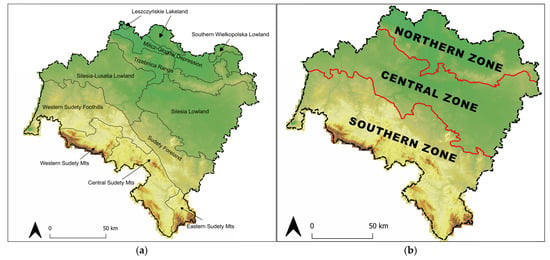
Figure 3.
(a) The physico-geographical macro-regions of Lower Silesia; (b) zones demarcated for research. Source: own elaboration.
- Southern Zone (SZ): comprising mountainous areas, foothills, and foreland regions (Sudetes, Western Sudetes Foothills, and Sudetes Foreland).
- Central Zone (CZ): encompassing lowland areas in the regional centre (Silesia-Lusatia Lowlands and Silesia Lowland).
- Northern Zone (NZ): including the Trzebnica Range (moraine ridges), Milicz-Głogów Depression (the main axis is the Barycz river valley), and small fragments of other physical–geographical units, geographically and culturally more connected with the Great Poland region to the north.
This zoning does not fully align with historical settlement networks, the territorial ranges of specific archaeological cultures, or medieval tribal boundaries. Instead, it is designed to facilitate one of the study’s primary objectives: to test the method’s criteria. The authors posit that the division into zones allows for testing the universality of the method, i.e., checking the possibility of its application to the same types of monuments, but located in regions with different forms of relief (mountains, foothills, lowlands). At the same time, it will allow for verification of whether or not the criteria selected in the method overlook important features of hillforts in a given group (zone), which may affect their tourist potential and—in the absence of their assessment—would automatically lower the score for a given object. This assumption also works the other way round; i.e., it aims to check whether or not some of the features of the environment, resulting from the location in a given zone, cause a falsely high score for the assessment of the site.
The authors acknowledge the limitations of the methodology, recognising the discrepancy in the spatial delimitation methods employed. Tourist attractiveness is measured at the poviat level, rather than for physico-geographical areas, as these administrative units are primarily responsible for managing tourism resources and determining their utilisation. However, as previously explained, physico-geographical regions in the context of this study enable the delineation of areas characterised by distinct forms of gords, thereby providing a foundation for rigorously verifying the selection of criteria. This, in turn, ensures that a single methodological framework can assess diverse hillforts and, consequently, facilitate comparative analysis of their attractiveness.
3.3. Resources and Research Methods
The inventory was conducted through desk research utilising secondary sources. Key resources included the Archaeological Heritage Inventory and the Register of Archaeological Monuments. These official registries were supported by the archaeological literature addressing sites from various periods, notably the early Middle Ages [97,98,101,102] and the late Middle Ages [103]. They were supplemented by works presenting the latest recognised sites [96] and tourism analysis of the archaeological sites in the region [104].
From the inventoried hillforts (Figure 4), in the next step, all established archaeological attractions were excluded, as these fell outside the present study’s purview. This task was carried out based on the analysis of results conducted as part of another, previous study focusing on archaeological attractions in the region [104]. As a result, the number of undeveloped hillforts in the entire Lower Silesian Voivodeship, distributed in all three terrain zones distinguished earlier, was finally obtained.
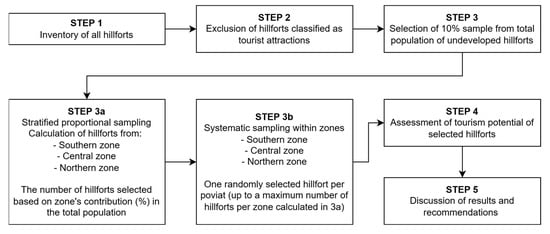
Figure 4.
The research procedure. Source: own elaboration.
To validate the assessment method, a representative 10% sample of the undeveloped hillfort population was deemed methodologically sufficient. Considering delineated terrain zones described in the previous chapter, a stratified proportional sampling technique was implemented to ensure zonal representativeness, with stratum-specific sample sizes reflecting each zone’s proportional contribution to the total population.
Within-zone selection was carried out by systematic sampling. The aim was to mitigate risks of spatially clustered selection, which could bias the results by occurrence of overrepresentation of one typological form of gord (e.g., potential concentration of one specific fortification type associated with tribal territory). It was assumed that the location of the selected hillforts would be relatively evenly distributed over the area of each zone (and the voivodeship), which would allow for the capturing of different types of hillforts in the assessment.
The culminating phase of the research involved a systematic evaluation of tourism potential within a curated sample of hillforts, operationalised through the methodological framework detailed in the subsequent section. Field investigations were conducted across all selected sites to collect primary data. To assess some criteria, secondary datasets from geoportals (https://mapy.zabytek.gov.pl/nid/, access: 10 April 2025; http://geoportal.dolnyslask.pl/, access: 11 April 2025), including LiDAR layers and digital and printed tourist maps (mapa-turystyczna.pl, mapy.cz), were incorporated as well.
3.4. Assessment Method of Tourism Potential of Hillfort
To achieve the research objectives, a methodological framework was developed to evaluate the tourism potential of hillforts. This tool employs a weighted scoring system, wherein distinct criteria are assigned numerical values, with the aggregate score reflecting the site’s overall potential. The proposed framework categorises evaluation criteria into three principal groups (Table 3):

Table 3.
Criteria of assessment of hillforts. Source: own elaboration.
- Physical characteristics;
- Surroundings and accessibility;
- Information visibility.
Detailed information of variables within each category, alongside their scoring system and descriptions of indicators, is provided in Appendix A.
Sites receive points for attributes that enhance their touristic appeal, with the magnitude of points contingent on the quality of the assessed feature (i.e., higher scores correspond to more favourable attributes). The maximum achievable score across all criteria is 75 points, representing maximum (very high) tourism potential.
Tourism potential was stratified into four tiers based on percentile thresholds relative to the total attainable score (Table 4).

Table 4.
Tourism potential tiers. Source: own elaboration.
4. Results and Discussion
4.1. Inventory and Hillforts as Attractions in Lower Silesia
The inventory process identified 280 existing, confirmed, or presumed hillforts. Among these, 30 sites qualify as formal tourist attractions under N. Leiper’s definition [105], characterised by physical infrastructure such as educational signage enabling their recognition and identification in situ (Table 5). Among the identified heritage attractions (Figure 5), a pronounced spatial concentration is evident: 20 sites (67%) are located in the southern zone, 7 in the central zone, and only 3 in the northern zone. This distribution highlights significant disparities in tourism infrastructure development across the voivodeship’s geographical areas.

Table 5.
Hillforts classified as tourist attractions—the numbers of objects correspond to Figure 5. Source: own elaboration.
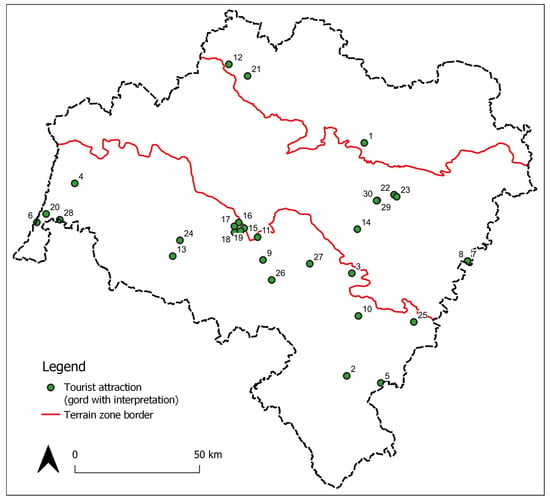
Figure 5.
Distribution of hillforts classified as tourist attractions (objects with physical interpretation in situ; n = 30). Source: own elaboration.
Among the attractions, the most common form of infrastructure is a single educational board, typically providing information about the hillfort’s history, archaeological research, and findings. In six attractions, development took the form of educational trails consisting of at least several information boards. In some locations (e.g., Gniewków, site 1; Bystrzyca, site 33), these were combined with nature trails, offering a comprehensive interpretation of both natural and cultural heritage. Only the hillforts in Będkowice (site 1) and Obiszów (site 2) feature reconstructed buildings, with the latter also including reconstructions of palisades and the hillfort gate. The information about reconstructions provided for Romanów (site 1) refers to castle relics, not the hillfort itself. Merely three sites have additional infrastructure for enjoying scenic views, in the form of observation towers or platforms (e.g., Jelenia Góra, site 2; Obiszów, site 2).
The results indicate that only a small proportion of all existing gords in Lower Silesia have so far been developed for tourism. Despite this, the impact of such initiatives on the region’s sustainable development is highly significant and can be demonstrated through examples of attractions near three villages, each with fewer than 500 inhabitants.
In the forest near the village of Bagno (Figure 5, Table 5, no 1), there is a medieval motte-type stronghold (12th–13th century) in the form of a mound with a clearly visible water-filled moat. In the early 20th century, a stone bridge, a monumental cross, and the grave of the German owner of the village (Figure 6a) were established here. Long neglected over the years, the site is now managed by the local community, which founded the association “Razem dla Bagna” (Together for Bagno). Its members cleared the area of the gord of vegetation and are maintaining it in good condition. An informational plaque describing the monument and indicating the access path has been installed next to the asphalt road (Figure 6b). This example illustrates how local communities preserve historical memory, including that of the Germans, who inhabited these lands until 1945.
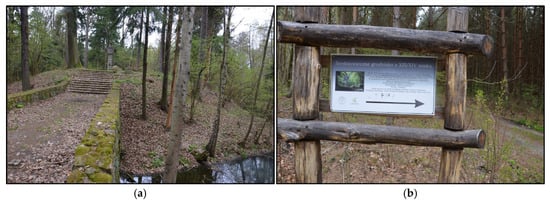
Figure 6.
Hillfort in Bagno, site 1. (a) View of the mound and wet moat, stone bridge, and cross in the background. (b) A board describing the site with an arrow indicating the direction of the path to the hillfort. Source: own elaboration.
Another good example of hillfort development is the site in Gniewków (Figure 5, Table 5, no 11), though the monument is located closer to another small settlement, Bolkowice. A resident of this village initiated the creation of tourist infrastructure at the archaeological site. Very near the fortification is situated his family home, where he established the educational farm “Cicha Barta” (Figure 7a), offering various activities for tourists related to the so-called dying professions (potter, blacksmith, beekeeper). The educational programmes are tailored for visitors of all ages and cover pottery-making, the history of blacksmithing, weaving, and beekeeping activities [106].
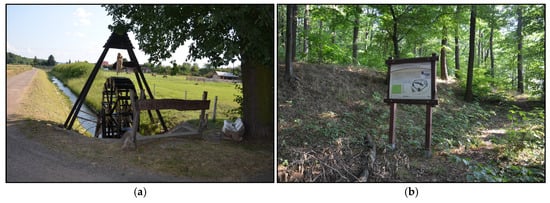
Figure 7.
(a) View of a part of the “Cicha Bartna” educational farm: on the left, the dirt road to the Gniewków hillfort (site 1) is visible. (b) A board of the archaeological educational trail on the hillfort. Source: own elaboration.
The farm owner is deeply interested in the region’s history, particularly the Gniewków gord, near which he has lived since childhood. Due to his strong attachment to the site, he assisted archaeologists during two excavation seasons in 2007–2008. After their completion, he requested help in creating an educational trail based on the research findings (Figure 7b), aiming to enhance his farm’s offerings by guiding tourists to the genuine archaeological site. He sourced funding, obtained approvals from local authorities and heritage conservators, and persuaded village farmers to allocate a strip of land for access to the monument. He also engaged other village residents in the project, dedicating his personal time, all driven by the profound personal value the fortification holds for him. Observing the results, local forestry authorities established a nature trail adjacent to the archaeological path. This example effectively demonstrates how an archaeological monument can be reclaimed by a local community: through their efforts, they safeguard and protect it while wisely integrating it into their developing economic activities.
Another attraction developed around archaeological monuments is the large tourist and recreational complex in Obiszów (Figure 5, Table 5, no 21). The site encompasses several archaeological sites, with the most thoroughly researched being the gord (site 2) and a nearby settlement. Based on these, a tourist attraction was created, featuring a full-scale reconstruction of the gord (with palisade, entrance gate, and three buildings) and an educational trail with 10 informational panels in three languages: Polish, English, and German (Figure 8).
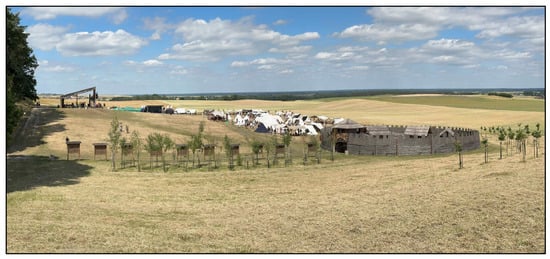
Figure 8.
General view of the reconstruction of the Obiszów gord (site 2). In the foreground, educational trail boards are visible. In the background, on the left, a viewing platform, and on the right, reenactors’ tents during an outdoor event. Source: own elaboration.
The complex is traversed by hiking trails and includes extensive recreational infrastructure nearby: a viewing platform, a bike park, a pump track, playgrounds, a nature trail, a soccer field, a campsite, and an outdoor gym. The site is open year-round and serves as a hub for local community integration, hosting historical reenactments with performances of ancient traditions and customs. An example is the June 2025 “Palinocka w Krainie Dziadoszan” (The Night in the Dziadoszanie Land Festival), which supported numerous initiatives related to sustainable development. The event was organised by commune authorities, local residents, and invited reenactment and musical groups.
In addition to opportunities for local producers to sell artisanal goods (honey, wines, craft beers), the programme focused on historical reenactments, including a nationally significant event: the meeting between German Emperor Otto III and Bolesław the Brave, later the first King of Poland (Figure 9a). Historical education was emphasised through a lecture by a renowned medievalist from the University of Wrocław (Figure 9b). Specialists from across the country also demonstrated reconstructions of medieval daily life (Figure 10a) and sold items replicating artefacts discovered during archaeological excavations (Figure 10b).
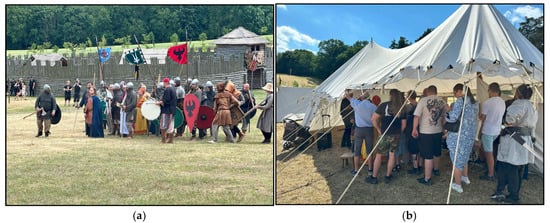
Figure 9.
The tourist–archaeological complex in Obiszów. (a) Reconstruction of the meeting between Emperor Otto III and Bolesław the Brave in the year 1000. (b) Tourists and local residents during a lecture by a historian about the settlement in Obiszów and its surroundings. Source: own elaboration.
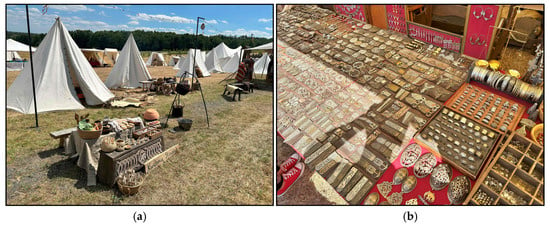
Figure 10.
The tourist–archaeological complex in Obiszów. (a) Reconstructions of everyday objects from the Middle Ages. (b) Replicas of jewellery and clothing elements made based on archaeological artefacts (on sale). Source: own elaboration.
These aspects exemplify sustainable development in social and economic dimensions. However, the Obiszów tourist–archaeological complex also holds environmental significance: its design and location at the forest edge intentionally integrate it with protected woodland areas and trails within them. Educational panels near the gord’s reconstruction further highlight the profound importance of nature in the daily lives of medieval inhabitants.
4.2. Tourism Potential Assessment of Selected Hillforts
After excluding developed attractions, 250 hillforts remained as potential tourism assets. Their spatial distribution across the voivodeship is approximately uniform (Figure 11):
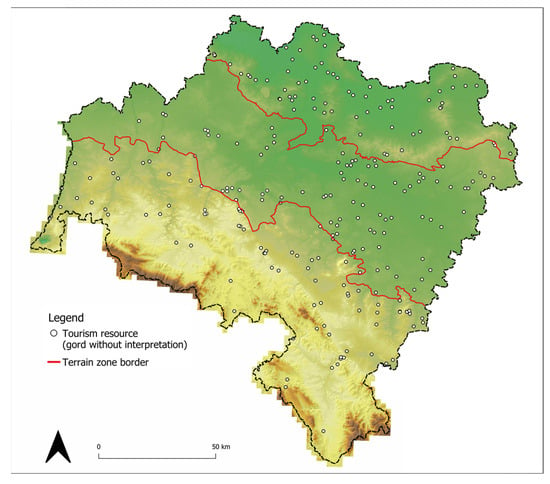
Figure 11.
Distribution of hillforts classified as potential tourism resources (objects without physical interpretation in situ; N = 250). Source: own elaboration.
- Southern Zone: 87 hillforts (35% of the total);
- Central Zone: 93 hillforts (37%);
- Northern Zone: 70 hillforts (27%).
The spatial distribution of hillforts demonstrates relative uniformity, though each terrain zone exhibits areas of notable absence of gords (“white spots”). To a large extent, these lacunae are related to disparities in archaeological research across the region and the documented destruction of numerous sites throughout the province. This phenomenon stems from post-medieval settlement patterns that obliterated earlier structures. An additional factor is landscape-altering economic activity, predominantly agricultural practices.
Distinct factors in a given terrain zone could also be distinguished. In the southern zone, hillforts cluster clearly in foothill areas and lower mountains. These locations offered synergistic advantages: favourable climatic and pedological conditions, reliable water access, and terrain conducive to fortification construction. Conversely, no hillforts occur in the highest parts of the mountains.
The northwestern sector of the central zone similarly displays a complete absence of hillforts. This pattern correlates with the area’s historical role as a borderland, preserved as extensive, dense woodlands, named Lower Silesia Wilderness (Polish: Bory Dolnośląskie).
In accordance with the methodological framework, a 10% sample (i.e., 25 sites) was selected from the total population of 250 undeveloped hillforts. Following the determination of the proportional representation of each territorial zone within the overall hillfort population, these percentages were converted into the requisite number of sites to be drawn from each zone, ensuring that the final sample comprised 25 hillforts. The results obtained are as follows:
- 9 hillforts from the southern zone;
- 9 from the central zone;
- 7 from the northern zone.
The geographic location and basic information of the sampled sites are presented in Figure 12 and Table 6.
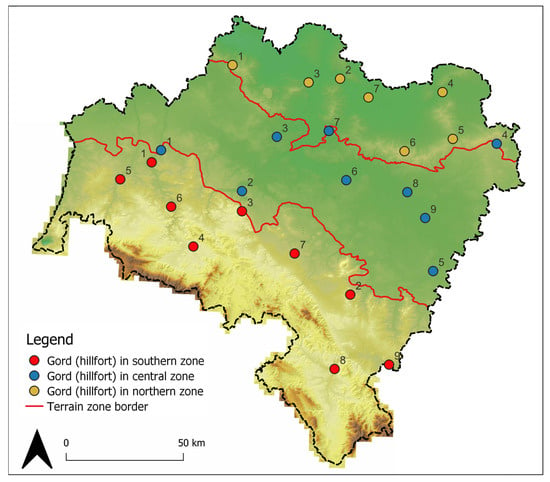
Figure 12.
Hillforts from each zone selected for research—the numbers of objects in each zone correspond to Table 6. Source: own elaboration.

Table 6.
Hillforts selected for research—the numbers of objects in each zone correspond to Figure 12. Source: own elaboration.
The results demonstrate that the majority of sites (19 hillforts) exhibit high tourism potential (Figure 13). Notably, no hillforts were rated at the low level. Detailed scores across all criteria for individual sites are presented in Table 7. In the northern zone, all hillforts received high potential ratings (with one site achieving a very high level), scoring between 44 points (Chobienia, site 3) and 63 points (Trzebnica, site 3). The remaining two zones exhibited similar patterns, with a predominance of sites classified as high-potential. In the central zone, three sites, and in the southern zone, two sites, were categorised as having moderate potential. Within the central zone, scores ranged from 38 points (Dziesławice, site 1) to 53 points (Krajów, site 1; Kadłub, site 4). In the southern zone, sites received minimum scores of 40 points (Roztocznik, site 1; Otok, site 2) and maximum scores of 53 points (Boguszyn, site 1; Nowy Jaworów, site 1).
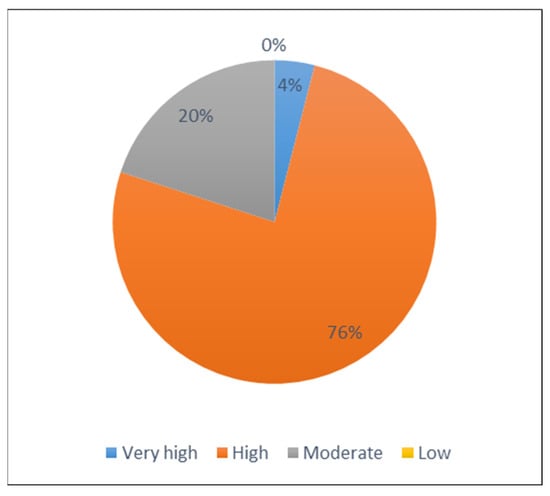
Figure 13.
Distribution of results of the tourism potential assessment of the selected hillforts. Source: own elaboration.

Table 7.
Results of tourism potential assessment of selected hillforts, grouped in zones. Source: own elaboration.
The mean aggregate score was approximately 49 out of 75 (65% of the maximum achievable points), with a standard deviation of 4.70 points. Category-specific performance for all sites together reveals the following average results:
- Category 1 (Site Characteristics): 70% of maximum points (ca. 29/40);
- Category 2 (Surroundings and Accessibility): 60% (ca. 15/25);
- Category 3 (Information Visibility): 56% (ca. 5,6/10) (Table 8).
 Table 8. The average results of tourism potential of hillforts for zones and total researched objects. Source: own elaboration.
Table 8. The average results of tourism potential of hillforts for zones and total researched objects. Source: own elaboration.
Zonal comparisons indicate that hillforts in the northern zone achieved the highest average scores, while the southern and central zones produced nearly identical results (Figure 14). However, mean scores across all three zones were closely clustered, differing by less than 3%. Northern-zone sites outperformed others in categories 1 and 2, whereas southern-zone sites demonstrated superior performance in category 3.
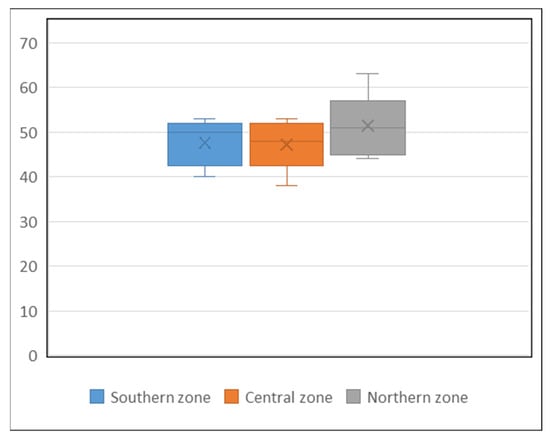
Figure 14.
Results of the tourism potential assessment of hillforts in three zones. Source: own elaboration.
4.3. Assessment of Physical Characteristics
The mean rating in the category of physical characteristics of the sites for all examined objects is 27.84, with a median of 28 (Table 8). Hillforts from the central and northern zones scored above the mean, while those from the southern zone scored slightly below, though the differences in results are marginal.
All sites, except one (Niemstów, site 6), are listed in the Register of Archaeological Monuments. This ensures their proper protection, which will preserve their landscape form and facilitate future research, thereby contributing new data for tourist interpretation. This is particularly significant, as 17 out of the 25 hillforts are confirmed to have functioned for at least one century, while 8 sites exhibit evidence of at least two settlement phases (spanning a minimum of two centuries). Consequently, future studies are expected to expand chronological knowledge of these hillforts, which is crucial for enhancing the quality of narratives developed for tourists [58].
The southern zone demonstrates the poorest research status (average rating of 2.89 out of 6), whereas the northern zone shows the best-researched monuments (average score of 4.86). This indicates that despite hosting the highest number of tourist attractions, including archaeological sites (Figure 5), the southern zone remains archaeologically understudied in some aspects, limiting broader tourist interpretations of the earliest history of this part of Lower Silesia.
The central zone achieved the highest scores in criteria related to preservation and structural complexity, exemplified by sites in Krajów, st. 2 (Figure 15), and Kadłub, st. 3 (Figure 16).
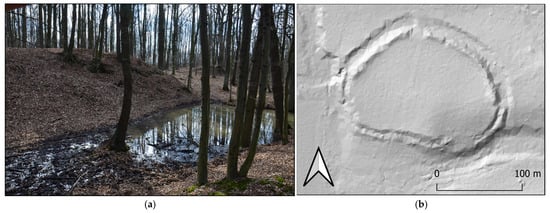
Figure 15.
Hillfort in Krajów, st. 2. (a) Part of earth walls from NE side, with visible wet ditch. (b) Lidar map of the object, showing the scale of the strongholds. Source: own elaboration.
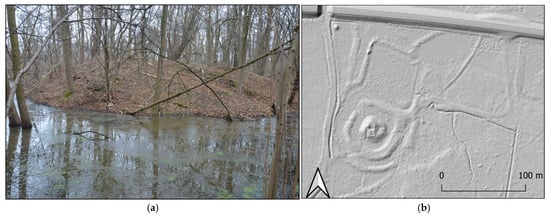
Figure 16.
Hillfort in Kadłub, st. 4. (a) Part of motte from E side, with visible wet ditch. (b) Lidar map of the object, showing the scale and complexity of the strongholds. Source: own elaboration.
The analysis reveals that complex sites achieving the maximum score are also present in other zones. In the mountainous zone, these include hillforts at Marczów, st. 1, and Chałupki, st. 1, while in the northern zone, Bełcz Mały, st. 1, and Bukowinka, st. 1, attained top ratings (Figure 17a).
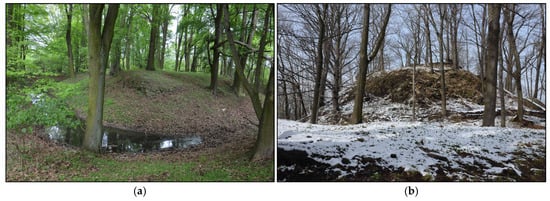
Figure 17.
(a) Hillfort in Bukowinka, st. 1. (b) Hillfort in Pomocne, st. 1 (Górzec). Source: own elaboration.
Regarding site visibility, all zones demonstrated comparable results (2.44 out of 3), with good visibility maintained across seasons, including autumn–winter and spring–summer periods (Figure 17). Although hillforts are typically associated with rural, forested landscapes, several selected sites are situated in urbanised areas and remain visually prominent (Figure 18). These factors significantly influence the potential to integrate the sites into tourism products aimed at distributing visitor traffic more evenly throughout the year, thereby supporting sustainable tourism development [107]. This aligns with environmental objectives by reducing overcrowding and facilitating site conservation, while also addressing economic goals through off-season tourist activity [57].
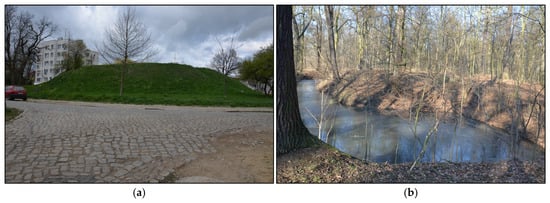
Figure 18.
Hillforts in urban areas. (a) Hillfort in Trzebnica, st. 3, in the town centre. (b) Hillfort in Wrocław-Sołtysowice, st. 2, in the public park. Source: own elaboration.
The prominence criterion yielded the highest scores in the northern zone (5.44 out of 6), attributable to the distinctive terrain conditions shaping fortification structures. However, lowland areas in the central and northern zones also achieved relatively high scores (mean above 4 out of 6; Table 8). This indicates that all selected sites possess clearly defined landscape forms (Figure 19), a critical factor in enhancing their archaeological tourism potential. The unique characteristics of hillforts, particularly their construction elements (ramparts), are emphasised as key for attracting tourists, with greater relief variations on site correlating to higher visitor appeal [108].
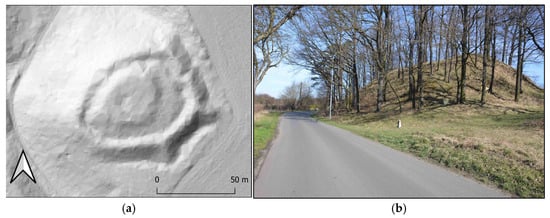
Figure 19.
(a) Lidar map of hillfort in Dankowice, st.1. (b) Hillfort in Nawojów Śląski, st. 1. Source: own elaboration.
In the viewpoint category, all three zones received low average scores (below 1.5 out of 3), a surprising result given the mountainous zone’s expected panoramic potential. This discrepancy stems from the majority of hillforts being located within or adjacent to forested areas, which typically lack scenic value. Such findings underscore the limited integration of visual landscapes into current site evaluations despite their theoretical significance for tourism [109].
4.4. Assessment of Surroundings, Accessibility, and Information Visibility
The highest mean scores in the category of accessibility and surroundings were recorded for sites in the northern zone, while the lowest were in the central zone (Table 8).
All 25 surveyed sites are located in open, public, and freely accessible areas, a critical positive factor enhancing their tourism potential.
In the criteria of proximity to tourist trails and site accessibility (nearby roads and paths), results were similarly favourable, with northern-zone sites achieving the highest scores in both categories. Of the 25 sites, nearly half (12 hillforts) are intersected by at least one tourist trail (5 sites each in the southern and northern zones). Only four sites (out of all) lack a tourist trail within a 500-metre radius. The presence of trails on or near hillforts (≤500 m) significantly supports sustainable infrastructure development, as it eliminates the need for additional investments and enables cost-effective integration of these sites into existing tourist attractions [110]. Furthermore, all sites are accessible via at least a visible footpath, with 25% (6 sites) adjacent to asphalt roads and 44% (11 sites) near clearly visible unsealed roads (field or forest tracks).
Each hillfort is located within a 1-hour walk (≤5 km) of the nearest bus stop or train station. Ten sites are within 1 km, while 15 are 1–5 km away, most commonly exceeding 3 km. Despite this positive assessment, a key limitation arises from the fact that most of these stops are situated in small villages. Given the operational characteristics of rural public transport in Poland [111], this raises concerns about the reliability of schedules and the potential non-operational status of some stops, significantly undermining the credibility of this criterion.
This study revealed poor outcomes for the criterion of proximity to other archaeological sites. Proximity to archaeological attractions was documented in only two cases within the northern belt: the hillforts at Dankowice, st. 1, and Trzebnica, st. 3. In the first case, the nearby modestly developed hillfort in Jakubów was noted, while in Trzebnica, the archaeological attraction is the Winna Góra site, where the oldest traces of human activity in Polish territories were discovered. To disseminate this information, an educational trail was established [104]. For the remaining hillforts, this criterion received low ratings, as other archaeological sites either are absent or occur sporadically within a 5 km radius. This limitation significantly hinders the potential utilisation of these resources for developing products tailored to archaeological tourism [27].
Better results were observed for the criterion of proximity to other tourist attractions, albeit primarily those of regional or local significance. Notably, all 25 analysed sites are located within 5 km of at least one attraction. Specifically, one hillfort lies within 1 km of a supra-regional attraction, another is similarly proximate to a regional attraction, and nine are in the immediate vicinity of local attractions. As with the criterion assessing proximity to trails, these findings suggest that the examined archaeological sites could be easily integrated into the existing tourism systems of their respective areas. This opportunity is an important factor mainly for development of remote rural areas of the region [112].
The visibility criterion evaluated the extent to which awareness of selected heritage sites is reflected in the tourist and specialist literature. Given the tourism-oriented focus of the research, greater emphasis was placed on the presence of information in the tourist literature, as it serves as the primary resource for visitors. Within category 3, the highest average scores were observed for sites in the southern belt (Table 8), a trend partially attributable to the extensive body of geographical and historical literature pertaining to the Sudetes region. However, northern-belt sites scored highest for visibility in travel guides, surprisingly.
This study also examined the presence of sites on geocaching platforms, a globally popular form of active tourism combining cultural and adventure elements [113]. Among the twenty-five hillforts, geocaches were documented at seven (predominantly in the southern belt), with three additional sites having caches within 200 metres. The presence of geocaches indicates that these sites already attract visitors, positioning them as niche tourism attractions.
5. Conclusions
5.1. Evaluation of Method and Recommendations
This study enabled the testing and critical evaluation of the proposed methodology, yielding several conclusions and corresponding recommendations for methodological refinements.
Key observations:
- Source accessibility limitations—challenges arose in accessing up-to-date archaeological literature and artefact typologies due to the fragmented availability of publications. Additionally, the level of detail in excavation publications varied significantly across sites.
- Tourism potential beyond physical attributes—despite low ratings in physical characteristics for certain sites, their tourism potential remained considerable due to locational advantages, surrounding infrastructure, or contextual features. For example, the hillfort in Boguszyn, physically combined with a religious landmark (chapel), equipped with accessible parking, and offering panoramic views, demonstrated high potential despite modest physical scores.
The proposed tool successfully emulated the multidimensional approach observed in established methodologies [83,84,85,86,87], proving effective for assessing tourism potential. However, the following revisions to the scoring system are recommended:
- Expand or separate evaluative categories—differentiate between research history and artefact typology assessments to reduce conceptual overlap.
- Integrate historical sources—introduce a criterion assessing historical written records, which are critical for constructing site narratives.
- Evaluate structural remains—add a category for assessing preserved structural features (e.g., stone/brick constructions) that enhance landscape appeal.
- Re-calibrate scenic value metrics—diminish the weight assigned to viewpoint assessments.
- Incorporate risk analysis: integrate criteria for safety considerations for both tourists (e.g., terrain hazards) and sites (e.g., visitor-induced degradation).
The tested methodology should serve as a preliminary screening tool for tourism potential. Sites yielding positive results warrant subsequent analyses focused on functional factors for heritage valorisation, including the following:
- Stakeholder engagement: assessing the willingness and capacity of local authorities and communities to participate in site stewardship.
- Collaborative frameworks: evaluating partnerships with conservation and archaeological authorities to ensure alignment with preservation standards.
- Interpretative feasibility: determining the viability of reconstructions and heritage interpretation strategies to enhance visitor engagement.
5.2. Final Results and Further Research
Regarding the formulated hypotheses, the following conclusions were drawn:
- Hypothesis 1 (due to the distribution of hillforts across zones with distinct terrain morphologies, hillforts exhibit significant variations in tourism potential scores) was rejected. The mean scores for tourism potential across all three zones demonstrated negligible variation, indicating comparable levels of assessed value.
- Hypothesis 2 (hillforts in the southern zone achieve the highest tourism potential ratings, reflecting the region’s established reputation as Lower Silesia’s most touristically attractive area) was also rejected, as the northern zone yielded the highest mean scores.
Despite the rejection of both hypotheses, the research objective—a preliminary assessment of the tourism potential of hillforts in the Lower Silesian Voivodeship—was achieved. A significant majority of sites (19 out of 25) were classified as having high tourism potential. Notably, the mean score of ~49/70 points places this result near the lower threshold for the “high” category (45–59 points). Only one site attained a very high rating, while the remaining five fell into the moderate category.
These promising outcomes suggest the feasibility of transforming archaeological monuments into tangible tourist attractions, thereby supporting development in the region [21]. This approach is supported by three presented examples of archaeological attractions in Lower Silesia, created on the basis of hillforts: in Bagno, Gniewków, and Obiszów. Their scales are different, but in each case, the positive social and economic effects of sustainable tourism development are clearly visible. The spatial distribution of underutilised hillforts across the voivodeship highlights opportunities to develop infrastructure in proximity to these sites, particularly in less frequented areas such as the northern, northwestern, and central lowland regions of Lower Silesia. Such initiatives could mitigate overtourism in popular zones while enabling local communities to derive benefits from increased visitor activity [4].
Furthermore, fostering community engagement in hillfort preservation—through educational programmes, participatory conservation efforts, and heritage valorisation—advances the social and environmental pillars of the triple bottom line framework. The former is realised by nurturing local patriotism and identity rooted in cultural heritage [32], while the latter enhances monument protection, as residents with strong ties to these sites often evolve into voluntary custodians [39], like in the case of Bagno village.
Given the positive outcomes for most sites, this study recommends expanding research to encompass all inventoried hillforts, with particular emphasis on northern and central areas. These regions, frequently assessed as the least attractive in broader studies [13], stand to benefit most from archaeotourism attractions.
Author Contributions
Conceptualisation, D.W. and K.W.; methodology, D.W.; software, not applicable; validation, K.W.; formal analysis, D.W.; investigation, D.W.; resources, K.W.; data curation, D.W.; writing—original draft preparation, D.W. and K.W.; writing—review and editing, D.W.; visualisation, D.W.; supervision, K.W.; project administration, D.W.; funding acquisition, K.W. All authors have read and agreed to the published version of the manuscript.
Funding
This research received no external funding.
Institutional Review Board Statement
Not applicable.
Informed Consent Statement
Not applicable.
Data Availability Statement
Data is contained within the article.
Conflicts of Interest
The authors declare no conflict of interest.
Appendix A
Assessment method of tourism potential of hillfort—descriptions of criteria and indicators with scores
Category 1: Physical Characteristics (40 points)
| Criterion | Indicators and Scores |
| Site status * | 4—Confirmed archaeological site recorded in the Register of Archaeological Monuments 3—Confirmed archaeological site listed in the Archaeological Heritage Inventory or presumed site recorded in the Register of Archaeological Monuments 2—Confirmed site not recorded in the register or inventory or presumed site recorded in the Archaeological Heritage Inventory 1—Presumed site recognised by specialists (archaeologists or related fields) but unregistered 0—Presumed site identified by amateurs (e.g., enthusiasts) |
| Chronology and archaeological cultures | 3—A site with a confirmed chronology spanning ≥2 settlement phases and/or usage dating to ≥2 centuries and/or associated with ≥2 archaeological cultures 2—A site with a confirmed chronology spanning 1 settlement phase and/or usage dating to 1 century and/or associated with 1 archaeological culture 1—A site with tentative chronology/archaeological culture 0—A site with undetermined chronology/archaeological culture |
| Research, documentation, literature | 6—Open-area excavations yielding abundant artefacts (incl. rare/unique), providing extensive knowledge about the site presented in documentation and/or publications 5—Open-area excavations yielding common artefacts, providing extensive knowledge about the site presented in documentation and/or publications 4—Test excavations (trial pits) with rare and common artefacts, providing significant verified knowledge about the site presented in documentation and/or publications 3—Test excavations (trial pits) with common artefacts, providing significant verified knowledge about the site or surface surveys with rare finds, presented in documentation and/or publications 2—Surface surveys with common artefacts, providing basic knowledge about the site, presented in documentation and/or publications 1—Surface surveys without artefacts, with basic description in documentation and/or publications 0—No research, documentation, or literature |
| State of preservation | 4—A well-preserved site without damage 3—A well-preserved site with minor damage (e.g., partial damage to earth walls or motte/mound) 2—The surface of the site is ≥50% preserved, retaining structural components, allowing typological identification 1—The surface of the site is ≥50% preserved, without structural components, or the site preserves <50% of the surface, but with structural elements (e.g., part of the earth wall) 0—A site destroyed by more than 50%, without characteristic elements or with elements of objects that are difficult to recognise and identify |
| Site complexity | 3—Multi-component site with clear boundaries (e.g., fortified settlement with bailey/suburb and ditch/moat) 2—Two-component site with clear boundaries (e.g., gord in form of hill with ditch or earth walls) 1—Single-component site with clear boundaries (e.g., simple motte without ditch) 0—A site without clear boundaries, difficult to recognise in the landscape |
| Site size | 4—Very large (>1 ha) 3—Large (>0.5–1 ha) 2—Medium (>0.1–0.5 ha) 1—Small (0.01–0.1 ha) 0—Very small (<0.01 ha) |
| Site visibility | The number of directions (sides) from the outside, from which the site can be observed: 3—Fully visible from all sides, ≥1 unobstructed views 2—Visible from ≥2 sides with minor obstructions 1—Visible from 1 side with minor obstructions 0—Visibility obstructed from all sides |
| Land cover | 3—Open meadow/lawn or exposed terrain 2—Mixed cover (meadow/forest) with sparse undergrowth or treeless area with dense vegetation (e.g., grass) partially obscuring the visibility of the structural elements of the site 1—Park/forest with sparse undergrowth 0—Park/forest with dense undergrowth (shrubs/tall grass) severely limiting visibility of the site |
| Site prominence ** | Prominence above surrounding terrain 6—>4 m 5—>3–4 m 4—>2–3 m 3—>1.5–2 m 2—>1–1.5 m 1–0.5–1 m 0—<0.5 m |
| Viewpoint | 4—On site with a vast, multi-plan panorama 3—On site with an average (e.g., single-plan) panorama 2—Within 100 m, with a vast, multi-plan panorama 1—Within 100 m, with an average (e.g., single-plan) panorama 0—At a distance of more than 100 m |
| * In Poland, archaeological heritage is catalogued through two distinct tiers of documentation: (1) Register of Archaeological Monuments. (Rejestr Zabytków Archeologicznych)—The highest legal tier, comprising sites of exceptional historical, scientific, or cultural significance. (2) Archaeological Heritage Inventory. (Ewidencja Zabytków Archeologicznych)—A comprehensive administrative list maintained at the voivodship (województwo) level, encompassing all identified archaeological sites regardless of significance. ** In the case of multi-component sites, the highest element/object is taken into account. |
Category 2: Surroundings and Accessibility (25 points)
| Criterion | Indicators and Scores |
| Land accessibility | 4—Open area, fenceless, publicly accessible (e.g., state-owned forests, urban parks) 3—Open area, but with unclear ownership, or private land, fenceless, with access permitted 2—Closed area (e.g., private land), no possibility of entering the site, but with the possibility of approaching the object directly and observing it easily 1—Closed area (e.g., private), no possibility of entering the site, possibility of easy observation of the site from a distance of up to 50 m 0—Closed area (e.g., private), no possibility of entering the site, possibility of limited observation from a distance of up to 50 m or observation from a distance of over 50 m |
| Proximity to tourist trails | 5—At least 2 different trail types or at least 3 trails of one type crossing the site 4—2 trails of one type crossing the site 3—1 trail crossing the site 2—≤200 m from nearest trail 1—200–500 m from nearest trail 0—>500 m from trails |
| Type of access (road, path) | 4—Adjacent to the asphalt road 3— Adjacent to the unsealed road or within 100 m of an asphalt road with a clearly visible path 2—≤100 m from the unsealed road with a clearly visible path to the site or >100 to 500 m from the asphalt road with a clearly visible path to the site 1—100–500 m from the unsealed road with a clearly visible path to the site 0—>500 m from any road |
| Distance to public transport | Proximity to a train station or bus stop: 2—Within 1 km 1—>1 to 5 km 0—>5 km |
| Nearby archaeological sites | 3—Within 5 km from at least 1 developed site (tourist attraction) or at least 1 site of another type 2—At least 2 tourism resources (undeveloped sites) within a distance of 5 km 1—At least 1 tourism resource (undeveloped site) within a distance of 5 km 0—No sites within 5 km |
| Proximity to tourist attractions | 5—≤1 km from supra-regionally significant attraction 4—≤1 km from regionally significant attraction 3—≤1 km from locally significant attraction 2—>1 to 5 km from supra-regional attraction 1—>1 to 5 km from regional/local attraction 0—>5 km from any attraction |
| Parking availability | 2—≤200 m from site 1—>200 m–1 km 0—>1 km |
Category 3: Information visibility (10 points)
| Criterion | Indicators and Scores |
| Type of information source (points added up, max 8 points) | +3—A site presented in travel guides/travel portals +2—A site presented in specialised historical/geographic sources (regional studies) or regional websites +2—A site presented in open-access archaeological databases (e.g., zabytek.pl) or in archaeological publications +1—Marked on tourist maps 0—No information or erroneous data, e.g., the site is marked on the map wrongly |
| Geocaching presence | 2—Cache on site 1—Cache ≤200 m from site 0—Cache >200 m away |
References
- Bahn, P.G. Archaeology. The Essential Guide to Our Human Past, 1st ed.; Smithsonian Books: Washington, DC, USA, 2017. [Google Scholar]
- Walker, C.; Carr, N. Tourism and archaeology: An introduction. In Tourism and Archaeology. Sustainable Meeting Grounds; Walker, C., Carr, N., Eds.; Left Coast Press: New York, NY, USA, 2013; pp. 11–35. [Google Scholar]
- Kairišs, A.; Oļevska, I. Development Aspects of Archaeological Sites in Latvia. Arch. Litu. 2021, 22, 10–36. [Google Scholar] [CrossRef]
- Timothy, D.J.; Tahan, L.G. Archaeology and Tourism: Consuming, Managing and Protecting the Human Past. In Archaeology and Tourism: Touring the Past; Timothy, D.J., Tahan, L.G., Eds.; Channel View Publications: Bristol, UK, 2020; pp. 1–25. [Google Scholar]
- Burtenshaw, P. Tourism and the Economic Value of Archaeology. In Archaeology and Tourism: Touring the Past; Timothy, D.J., Tahan, L.G., Eds.; Channel View Publications: Bristol, UK, 2020; pp. 41–53. [Google Scholar]
- McGettingan, F.; Rozenkiewicz, A. Archaeotourism—The Past is Our Future? In Cultural Tourism; Raj, R., Griffin, K., Morpeth, N., Eds.; CABI: Wallingford, UK, 2013; pp. 118–128. [Google Scholar]
- Banasiak, P.; Wielocha, E. Sprawozdanie z ogólnopolskiej interdyscyplinarnej konferencji naukowej Forum Archeologii Publicznej. Popularyzacja i edukacja archeologiczna. In Forum Archeologii Publicznej. Popularyzacja I Edukacja Archeologiczna; Banasiak, P., Freygant-Dzieruk, M., Stawarz, N., Wielocha, E., Eds.; ArchaeGraph Wydawnictwo Naukowe: Łódź, Poland; Toruń, Poland, 2020; pp. 11–24. [Google Scholar]
- UNWTO. Global Report on the Power of Youth Travel. Available online: https://www.wysetc.org/wp-content/uploads/2016/03/Global-Report_Power-of-Youth-Travel_2016.pdf (accessed on 30 April 2025).
- Ketter, E. Millennial travel: Tourism micro-trends of European Generation Y. J. Tour. Futures 2020, 7, 192–196. [Google Scholar] [CrossRef]
- Polish Tourism Organization. Available online: https://ttgpolska.pl/rafal-szmytke-ocena-polskiego-sezonu-turystycznego-2024/ (accessed on 30 April 2025).
- Occupancy of Tourist Accommodation Establishments in 2024. Statistics Poland. Available online: https://stat.gov.pl/en/topics/culture-tourism-sport/tourism/occupancy-of-tourist-accommodation-establishments-in-2024,11,3.html (accessed on 30 April 2025).
- Turystyka w Województwie Dolnośląskim w 2023 r. Statistical Office in Wrocław. Available online: https://wroclaw.stat.gov.pl/opracowania-biezace/opracowania-sygnalne/kultura-sport-turystyka/turystyka-w-wojewodztwie-dolnoslaskim-w-2023-r-,1,12.html (accessed on 30 April 2025).
- Analiza Walorów Turystycznych Powiatów I Ich Bezpośredniego Otoczenia. Statistics Poland. Available online: https://stat.gov.pl/statystyki-eksperymentalne/uslugi-publiczne/analiza-walorow-turystycznych-powiatow-i-ich-bezposredniego-otoczenia,1,1.html (accessed on 30 April 2025).
- Klimek, S.; Urbanek, M. Journeys Through Lower Silesia; Via Nova: Wrocław, Poland, 2007. [Google Scholar]
- Czerwiński, J. Dolny Śląsk. Przewodnik, 2nd ed.; EkoGraf: Wrocław, Poland, 2013. [Google Scholar]
- Rogowski, M. Diagnoza i Optymalizacja Turystyfikacji (Zjawiska Overtourism’u) w Parku Narodowym. Available online: https://kpn.gov.pl/pliki-do-pobrania/otworz/a5a99070-0634-4b25-aea6-302b32fb3d4f.pdf (accessed on 30 April 2025).
- Rogowski, M. A method for overtourism optimisation for protected areas. J. Outdoor Recreat. Tour. 2025, 49, 100859. [Google Scholar] [CrossRef]
- Analiza Ruchu Turystycznego We Wrocławiu w Roku 2024. Available online: https://www.wroclaw.pl/beta2/files/dokumenty/769556/Prezentacja%20-%20Ruch%20Turystyczny%20we%20Wroc%C5%82awiu%202024.pdf (accessed on 30 April 2025).
- Register of Archaeological Monuments. Available online: https://dane.gov.pl/pl/dataset/210 (accessed on 23 June 2025).
- Timothy, D.J. Cultural Heritage and Tourism. An Introduction; Channel View Publications: Bristol, UK, 2013. [Google Scholar]
- Timothy, D.J.; Erdoğan, H.A.; Samuels, J. Archaeological Heritage and Tourism: The Archaeotourism Intersection. Conserv. Manag. Archaeol. Sites 2024, 26, 103–112. [Google Scholar] [CrossRef]
- Baram, U. Tourism and archaeology. In Encyclopedia of Archaeology, 1st ed.; Pearshall, D.M., Ed.; Academic Press: Cambridge, MA, USA, 2007; pp. 2131–2134. [Google Scholar]
- Al-Busaidi, Y. Public Interpretation of Archaeological Heritage and Archaeotourism in the Sultanate of Oman. Ph.D. Thesis, Cardiff School of Management: Cardiff, UK, 2008. [Google Scholar]
- Thomas, B.; Langlitz, M. Archaeotourism, archaeological site preservation, and local communities. In Feasible Management of Archaeological Heritage Sites Open to Tourism, 1st ed.; Comer, D.C., Willems, A., Eds.; Springer Cham: Cham, Switzerland, 2019; pp. 68–78. [Google Scholar]
- Giraudo, R.F.; Porter, B.W. Archaeotourism and the Crux of Development. Anthropol. News 2010, 51, 7–8. [Google Scholar] [CrossRef]
- Operational Guidelines for the Implementation of the World Heritage Convention. 2024. Available online: https://whc.unesco.org/en/guidelines/ (accessed on 21 June 2025).
- Zanier, K.; Senica, T. Archaeological Tourism Products: Towards a Concept Definition. Acad. Tur. Tour. Innov. J. 2023, 16, 205–220. [Google Scholar] [CrossRef]
- Pinter, T.L. Heritage Tourism and Archaeology: Critical Issues. SAA Archaeol. Rec. 2005, 5, 9–12. [Google Scholar]
- Boniface, P. Managing Quality Cultural Tourism, 1st ed.; Routledge: London, UK, 2003. [Google Scholar]
- Pacifico, D.; Vogel, M. Archaeological sites, modern communities, and tourism. Ann. Tour. Res. 2012, 39, 1588–1611. [Google Scholar] [CrossRef]
- Du Cros, H.; McKercher, B. Cultural Tourism, 2nd ed.; Routledge: London, UK; New York, NY, USA, 2014. [Google Scholar]
- Fyall, A.; Leask, A.; Barber, S.B. Marketing archaeological heritage for tourism. In Archaeology and Tourism: Touring the Past; Timothy, D.J., Tahan, L.G., Eds.; Channel View Publications: Bristol, UK, 2020; pp. 69–86. [Google Scholar]
- Fushiya, T. Archaeological Site Management and Local Involvement: A Case Study from Abu Rawash, Egypt. Conserv. Manag. Archaeol. Sites 2013, 12, 324–355. [Google Scholar] [CrossRef]
- A Guide to Best Practices for Archaeological Tourism. Available online: https://www.archaeological.org/pdfs/AIATourismGuidelines.pdf (accessed on 3 May 2025).
- Dhanjal, S. Archaeological sites and informal education: Appreciating the archaeological process. Conserv. Manag. Archaeol. Sites 2008, 10, 52–63. [Google Scholar] [CrossRef]
- Thomas, S. Community archaeology. In Key Concepts in Public Archaeology, 1st ed.; Moshenska, G., Ed.; UCL Press: London, UK, 2017; pp. 14–30. [Google Scholar]
- Bartecki, B. The Goths’ Return to the Hrubieszów Basin. The Social Use of Archaeological Heritage for Building a Local Identity. Analecta Archaeol. Ressoviensia 2018, 13, 333–355. [Google Scholar] [CrossRef]
- Hauf, D.S. The European Route of Megalithic Culture: Pathways to Europe’s Earliest Stone Architecture. In Feasible Management of Archaeological Heritage Sites Open to Tourism, 1st ed.; Comer, D.C., Willems, A., Eds.; Springer Cham: Cham, Switzerland, 2019; pp. 129–140. [Google Scholar]
- Schierhold, K. Westphalian Megaliths Go Touristic: Archaeological Research as a Base for the Development of Tourism, In Feasible Management of Archaeological Heritage Sites Open to Tourism, 1st ed.; Comer, D.C., Willems, A., Eds.; Springer Cham: Cham, Switzerland, 2019; pp. 141–150. [Google Scholar]
- Timothy, D.J.; Nyaupane, G.P. Cultural Heritage and Tourism in Developing World. A Regional Perspective, 1st ed.; Routledge: London, UK; New York, NY, USA, 2009. [Google Scholar]
- Copeland, T. Archaeological Heritage Education: Citizenship from the Ground Up. Treb. D’arqueologia 2009, 15, 9–20. [Google Scholar]
- Chowaniec, R. Archaeology for Everyone. Presenting Archaeological Heritage to the Public in Poland; Ministry of Science and Higher Education: Warsaw, Poland, 2017. [Google Scholar]
- Pawleta, M. Przeszłość We Współczesności. Studium Metodologiczne Archeologicznie Kreowanej Przeszłości w Przestrzeni Społecznej; Wydawnictwo Naukowe UAM: Poznań, Poland, 2016. [Google Scholar]
- Afkhami, B. Archaeological tourism; characteristics and functions. J. Hist. Archaeol. Anthropol. Sci. 2021, 6, 57–60. [Google Scholar] [CrossRef]
- Henson, D. Archaeology and education. In Key Concepts in Public Archaeology, 1st ed.; Moshenska, G., Ed.; UCL Press: London, UK, 2017; pp. 43–59. [Google Scholar]
- Chowaniec, R. Dziedzictwo Archeologiczne w Polsce. Formy Edukacji i Popularyzacji; Archaeology Institute of Warsaw University: Warsaw, Poland, 2010. [Google Scholar]
- Arias, A.G.A.; Escobar, J.J.M.; Padilla, R.T.; Matamoros, O.M. Historical-Cultural Sustainability Model for Archaeological Sites in Mexico Using Virtual Technologies. Sustainability 2020, 12, 7337. [Google Scholar] [CrossRef]
- Agnew, N.; Demas, M. Immovable Heritage: Appropriate Approaches to Archaeological Sites and Landscapes. In Encyclopedia of Global Archaeology, 2nd ed.; Smith, C., Ed.; Springer: New York, NY, USA, 2020; pp. 5554–5568. [Google Scholar]
- Zan, L.; Lusiani, M. Managing Change and Master Plans: Machu Picchu Between Conservation and Exploitation. Archaeologies 2011, 7, 329–371. [Google Scholar] [CrossRef]
- Anderson, C. The Effects of Tourism on the Cusco Region of Peru. J. Undergrad. Res. 2008, 11, 1–3. Available online: https://digitalcollections.uwlax.edu/jsp/RcWebImageViewer.jsp?doc_id=2db853e8-7ecd-4d4f-910a-2016874b2cda/wlacu000/00000013/00000376 (accessed on 30 April 2025).
- Mustafa, M.H.; Tayeh, S.A. The Impacts of Tourism Development on the Archaeological Site of Petra and Local Communities in Surrounding Villages. Asian Soc. Sci. 2011, 7, 88–96. [Google Scholar] [CrossRef]
- Comer, D.C. Tourism and Archaeological Heritage Management at Petra. Driver to Development or Destruction; Springer: New York, NY, USA, 2012. [Google Scholar]
- Miura, K. A note on the current impact of tourism on Angkor and its environs. Conserv. Manag. Archaeol. Sites 2007, 8, 132–135. [Google Scholar] [CrossRef]
- Germanà, M.L.; Kotarba-Morley, A.M. Ethics, Use, and Inclusion in Managing Archaeological Built Heritage: The Relationship Between Experts and Visitors/Users. In Encyclopedia of Global Archaeology, 2nd ed.; Smith, C., Ed.; Springer: New York, NY, USA, 2020. [Google Scholar]
- Mairna, H.M. Cultural Heritage: A Tourism Product of Egypt Under Risk. J. Environ. Manag. Tour. 2021, 1, 243–257. [Google Scholar] [CrossRef]
- Comer, D.C.; Willems, W. Tourism and Archaeological Heritage. Driver to Development or Destruction; ICOMOS: Paris, France, 2011; Available online: https://openarchive.icomos.org/id/eprint/1208/1/III-1-Article2_Comer_Willems.pdf (accessed on 3 May 2025).
- Almasri, R.; Ababneh, A. Heritage Management: Analytical Study of Tourism Impacts on the Archaeological Site of Umm Qais—Jordan. Heritage 2021, 4, 2449–2469. [Google Scholar] [CrossRef]
- Deeben, J.; Groenwoudt, B.J.; Hallewas, D.P.; Willems, W.J.H. Proposals for a practical system of significance evaluation in archaeological heritage management. Eur. J. Archaeol. 1999, 2, 177–199. [Google Scholar] [CrossRef][Green Version]
- Wurz, S.; Van der Merve, J.H. Gauging site sensitivity for sustainable archeotourism in the Western Cape Province of South Africa. S. Afr. Archaeol. Bull. 2005, 60, 10–19. [Google Scholar][Green Version]
- Wood, M.E. Ecotourism. Principles, Practices and Policies for Sustainability. UNEP. 2002. Available online: https://www.unep.org/resources/report/ecotourism-principles-practices-and-policies-sustainability (accessed on 2 May 2025).
- McKercher, B.; Du Cros, H. Cultural Tourism: The Partnership Between Tourism and Cultural Heritage Management, 1st ed.; Routledge: Abingdon, UK, 2002. [Google Scholar]
- Barrowclough, D. Visiting Malta’s Past: Sustaining Archaeology and Tourism. Available online: https://www.academia.edu/7691014/Visiting_Maltas_Past_Sustaining_Archaeology_and_Tourism (accessed on 2 May 2025).
- Slehat, M.M. Evaluation of Potential Tourism Resources for Developing Different Forms of Tourism: Case Study of Iraq Al-Amir and Its Surrounding Areas—Jordan. Ph.D. Thesis, Katholische Universität Eichstätt-Ingolstadt, Bavaria, Germany, 2018. Available online: https://edoc.ku.de/id/eprint/22441/ (accessed on 3 May 2025).
- Palumbo, G.; Al-Tikriti, W.Y.; Mahdy, H.; Al Nuaimi, A.; Al Kaabi, A.; Altawallbeh, D.E.; Muhammad, S.A.; Marcus, B. Protecting the Invisible: Site-Management Planning at Small Archaeological Sites in al-Ain, Abu Dhabi. Conserv. Manag. Archaeol. Sites 2014, 16, 145–162. [Google Scholar] [CrossRef]
- Avner, U. The potential of ancient sites in the Eliat Region for cultural tourism. In Tourism Destination Development and Branding, Conference Proceedings; Ben-Gurion University of the Negev: Eilat, Israel, 2009; pp. 107–126. Available online: https://www.academia.edu/16747680/The_Potential_of_Ancient_Sites_in_the_Eilat_Region_for_Cultural_Tourism?auto=download (accessed on 3 May 2025).
- Martínez-Hernández, C.; Mínguez, C.; Yubero, C. Archaeological Sites as Peripheral Destinations. Exploring Big Data on Fieldtrips for an Upcoming Response to the Tourism Crisis after the Pandemic. Heritage 2021, 4, 3098–3112. [Google Scholar] [CrossRef]
- Yunis, E. Archaeology and Tourism: A Viable Partnership? Introduction. In Of the Past, for the Future: Integrating Archaeology and Conservation; Agnew, N., Bridgland, J., Eds.; Getty Conservation Institute: Los Angeles, LA, USA, 2006; pp. 175–176. Available online: https://www.getty.edu/conservation/publications_resources/pdf_publications/of_past_for_future.html (accessed on 12 April 2025).
- Ramsey, D.; Everitt, J. If you dig it, they will come! Archaeology heritage sites and tourism development in Belize, Central America. Tour. Manag. 2008, 29, 909–916. [Google Scholar] [CrossRef]
- Timoney, S.M. Presenting Archaeological Sites to the Public in Scotland. Ph.D. Thesis, University of Glasgow, Scotland, UK, 2009. Available online: https://theses.gla.ac.uk/801/ (accessed on 15 April 2025).
- López, M.F.B.; Virto, N.R.; Manzano, J.A.; Garcia-Madariaga, J. Tourism sustainability in archaeological sites. J. Cult. Herit. Manag. Sustain. Dev. 2018, 8, 276–292. [Google Scholar] [CrossRef]
- López, M.F.B.; Virto, N.R.; Manzano, J.A.; Garcia-Madariaga, J. Archaeological tourism: Looking for visitor loyalty drivers. J. Herit. Tour. 2020, 15, 60–75. [Google Scholar] [CrossRef]
- Hidalgo-Fernández, A.; Hernández-Rojas, R.; del Rio, J.A.J.; Casas-Rosal, J.C. Tourist Motivations and Satisfaction in the Archaeological Ensemble of Madinat Al-Zahra. Sustainability 2019, 11, 1380. [Google Scholar] [CrossRef]
- Erdoğan, H.A.; Birsen, A.G.; Bilim, Y. Archaeotourist: A Novel Tourist Type in Heritage Tourism. Conserv. Manag. Archaeol. Sites 2024, 26, 134–154. [Google Scholar] [CrossRef]
- McGimsey, C.R.; Davis, H.A. The Management of Archaeological Resources: The Airlie House Report; Society of American Archaeology: Washington, DC, USA, 1977; Available online: https://documents.saa.org/container/docs/default-source/doc-publications/archive/airlie_house.pdf (accessed on 15 April 2025).
- Carman, J. The importance of things: Archaeology and the law. In Managing Archaeology, 1st ed.; Cooper, M.A., Firth, A., Carman, J., Wheatley, D., Eds.; Routledge: London, UK; New York, NY, USA, 1995; pp. 17–30. [Google Scholar]
- Kobyliński, Z.; Wysocki, J. Problemy wartościowania dziedzictwa archeologicznego. In Wartościowanie W Ochronie I Konserwacji Zabytków; Szmygin, B., Ed.; PKN ICOMOS: Warszawa, Poland; Politechnika Lubelska: Lublin, Poland, 2012; pp. 81–100. [Google Scholar]
- Kobyliński, Z. Kryteria i metody wartościowania dziedzictwa archeologicznego: Aktualny stan dyskusji. In System Wartościowania Dziedzictwa. Stan Badań I Problemy; Szmygin, B., Ed.; Politechnika Lubelska: Lublin, Poland; PKN ICOMOS: Warszawa, Poland, 2015; pp. 83–110. [Google Scholar]
- Glassow, M. Issues in evaluating the significance of archaeological resources. Am. Antiq. 1977, 42, 413–420. [Google Scholar] [CrossRef]
- Carver, M. On Archaeological Value. In Archaeological Sites: Conservation and Management; Sullivan, S., Mackay, M., Eds.; The Getty Conservation Institute: Los Angeles, LA, USA, 2013; pp. 295–312. Available online: https://www.getty.edu/conservation/publications_resources/books/arch_sites_conserv_mgmnt.html (accessed on 21 March 2025).
- Du Cros, H. A new model to assist in planning for sustainable cultural heritage tourism. Int. J. Tour. Res. 2002, 3, 165–170. [Google Scholar] [CrossRef]
- McKercher, B.; du Cros, H. Testing a Cultural Tourism Typology. Int. J. Tour. Res. 2003, 5, 45–58. [Google Scholar] [CrossRef]
- Mazzola, B. Archaeological Tourism Opportunity Spectrum: Experience Based Management and Design as Applied to Archaeological Tourism. Master’s Thesis, Utah State University, Logan, UT, USA, 2015. Available online: https://digitalcommons.usu.edu/cgi/viewcontent.cgi?params=/context/gradreports/article/1539/&path_info=auto_convert.pdf (accessed on 2 April 2025).
- Pralong, J.P. A method for assessing tourist potential and use of geomorphological sites. Geomorphologie 2005, 11, 189–196. [Google Scholar] [CrossRef]
- Reynard, E. Scientific Research and Tourist Promotion of Geomorphological Heritage. Geogr. Fis. E Din. Quat. 2008, 31, 225–230. [Google Scholar]
- Pereira, P.; Pereira, D. Methodological guidelines for geomorphosite assessment. Geomorphologie 2010, 2, 215–222. [Google Scholar] [CrossRef]
- Dmytrowski, P.; Kicińska, A. Waloryzacja geoturystyczna obiektów przyrody nieożywionej i jej znaczenie w perspektywie rozwoju geoparków. Probl. Ekol. Kraj. 2011, 29, 11–20. [Google Scholar]
- Doktor, M.; Miśkiewicz, K.; Welc, E.; Mayer, W. Criteria of geotourism valorization specified for various recipients. Geotourism 2015, 3–4, 25–38. [Google Scholar] [CrossRef]
- Brilha, J. Inventory and quantitative assessment of geosites and geodiversity sites: A review. Geoheritage 2016, 8, 119–134. [Google Scholar] [CrossRef]
- Kubalikova, L. Geomorphosite assesment for geotourism purposes. Czech J. Tour. 2013, 2, 80–104. [Google Scholar] [CrossRef]
- Chrobak, A. Review of the assessment methods of abiotic nature sites used in geotourism. Pr. Kom. Geogr. Przemysłu Pol. Tow. Geogr. 2021, 35, 116–145. [Google Scholar]
- Ihnatowicz, A.; Koźma, J.; Wajsprych, B. Wałbrzyski Obszar Geoturystyczny—inwentaryzacja geotopów dla potrzeb promocji geoturystyki. Przegląd Geol. 2011, 59, 722–731. [Google Scholar]
- Koźma, J.; Cwojdziński, S.; Ihnatowicz, A.; Pacuła, J.; Zagożdżon, P.P.; Zagożdżon, K.D. Możliwości rozwoju geoturystyki w regionie dolnośląskim na przykładzie wybranych projektów dotyczących inwentaryzacji i waloryzacji geostanowisk. In Mezozoik I Kenozoik Dolnego Śląska; Żelażniewicz, A., Wojewoda, J., Cieżkowski, W., Eds.; WIND: Wrocław, Polska, 2011; pp. 137–158. Available online: http://www.ptgeol.pl/wp-content/uploads/PTG_81_Zjazd_2011.pdf (accessed on 2 May 2025).
- Różycka, M. Atrakcyjność geoturystyczna okolic Wojcieszowa w Górach Kaczawskich. Przegląd Geol. 2014, 62, 514–521. [Google Scholar]
- Różycka, M.; Migoń, P. Visitors’ background as a factor in geosite evaluation. The case of Cenozoic volcanic sites in the Pogórze Kaczawskie region, SW Poland. Geotourism 2014, 3–4, 3–18. [Google Scholar] [CrossRef]
- Różycka, M.; Migoń, P. Customer-oriented evaluation of geoheritage—on the example of volcanic geosites in the West Sudetes, SW Poland. Geoheritage 2018, 10, 23–37. [Google Scholar] [CrossRef]
- Lisowska, E.; Jaworski, K. 8th–10th century hillforts in the Sudetes—exploring current state of research and observations, towards new horizons. Acta Archaeol. Carpath. 2021, 56, 335–386. [Google Scholar] [CrossRef]
- Chrzan, K. Kraina Grodów. Krajobraz Społeczności Zamieszkujących Obszar Między Środkową Obrą a Środkową Prosną W VIII–X/XI w. Ph.D. Thesis, IAE PAN, Wrocław, Poland, 2022. [Google Scholar]
- Rodak, S. Podstawy Datowania Grodów Z Końca X–Początku XIII W. Na Dolnym Śląsku; In pago Silensi—Wrocławskie Studia Wczesnośredniowieczne: Wrocław, Poland, 2017; p. 4. [Google Scholar]
- Herold, H. Strongholds and early medieval states. In The Routledge Handbook of East Central and Eastern Europe in the Middle Ages, 500–1300, 1st ed.; Curta, F., Ed.; Routledge: Oxfordshire, UK, 2021. [Google Scholar]
- Lepage, J.D. Dictionary of Fortifications: An Illustrated Glossary of Castles, Forts, & Other Defensive Works from Antiquity to the Present Day; Pen & Sword Military: Barnsley, UK, 2022. [Google Scholar]
- Kaletynowie, M.T.; Lodowski, J. Grodziska Wczesnośredniowieczne Województwa Wrocławskiego; Ossolineum: Wrocław, Poland, 1968. [Google Scholar]
- Jaworski, K. Grody w Sudetach (VIII-X w.); Uniwersytet Wrocławski: Wrocław, Poland, 2005. [Google Scholar]
- Nowakowski, D. Śląskie Obiekty Typu Motte. Studium Archeologiczno-Historyczne; IAE PAN: Wrocław, Poland, 2017. [Google Scholar]
- Werczyński, D. Stanowiska Archeologiczne na Dolnym Śląsku Jako Rzeczywiste Walory Turystyczne. Ph.D. Thesis, Institute of Geography and Regional Development, Wrocław, Poland, 2023. [Google Scholar]
- Leiper, N. Tourist attraction systems. Ann. Tour. Res. 1990, 17, 367–384. [Google Scholar] [CrossRef]
- Educational Farm “Cicha Bartna”. Available online: https://zagrodaedukacyjna.pl/zag_edu_farm/zagroda-edukacyjna-cicha-bartna/ (accessed on 29 June 2025).
- Widawski, K.; Krzemińska, A.; Zaręba, A.; Dzikowska, A. A Sustainable Approach to Tourism Development in Rural Areas: The Example of Poland. Agriculture 2023, 13, 2028. [Google Scholar] [CrossRef]
- Lijewski, T.; Mikułowski, B.; Wyrzykowski, J. Geografia Turystyki Polski, 5th ed.; PWE: Warszawa, Poland, 2008. [Google Scholar]
- Rogowski, M. Ocena walorów widokowych szlaków turystycznych na wybranych przykładach z Dolnego Śląska. Probl. Ekol. Kraj. 2009, 35, 155–163. [Google Scholar]
- Landorf, C. Cultural Value and Sustainable Development: A Framework for Assessing the Tourism Potential of Heritage Places. In Feasible Management of Archaeological Heritage Sites Open to Tourism, 1st ed.; Comer, D.C., Willems, A., Eds.; Springer Cham: Cham, Switzerland, 2019; pp. 7–20. [Google Scholar]
- Kaczorowski, J. Wykluczeni. O likwidacji transport zbiorowego na wsi i w małych miastach. Przegląd Planisty 2019, 4, 11–14. [Google Scholar]
- Mathews, J.P. Life on the B List:” Archaeology and tourism at sites that aren’t postcard worthy, In Tourism and Archaeology. Sustainable Meeting Grounds; Walker, C., Carr, N., Eds.; Left Coast Press: New York, NY, USA, 2013; pp. 58–59. [Google Scholar]
- Ihamäki, P. Geocachers: The creative tourism experience. J. Hosp. Tour. Technol. 2012, 3, 152–175. [Google Scholar] [CrossRef]
Disclaimer/Publisher’s Note: The statements, opinions and data contained in all publications are solely those of the individual author(s) and contributor(s) and not of MDPI and/or the editor(s). MDPI and/or the editor(s) disclaim responsibility for any injury to people or property resulting from any ideas, methods, instructions or products referred to in the content. |
© 2025 by the authors. Licensee MDPI, Basel, Switzerland. This article is an open access article distributed under the terms and conditions of the Creative Commons Attribution (CC BY) license (https://creativecommons.org/licenses/by/4.0/).